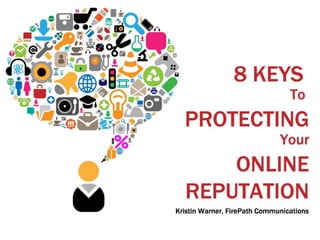8 keys to Protecting Your Online Reputation (ORM)
- 3. Google is the ŌĆ£Reputation EngineŌĆØ ŌĆó 83% of consumers say online reviews influence their perception of a company. ŌĆó 7 out of 10 of consumers trust online reviews as much as personal recommendations. ŌĆó 5 out of 10 consumers say they are more likely to use a local business that has a positive online reputation. ŌĆó 73% of users believe what they read online is true and accurate. ŌĆó 34% have turned to social media to air their feelings about a company. 26% to express dissatisfaction, 23% to share companies or products they like. SOURCES: ReachLocal Consumer Study, August 2012 Yahoo, May 2012 Harris Poll, April 2010
- 4. What is ORM? Proactively monitoring and influencing the organic search results for your company name, brand name or company leaders.
- 5. Key 1: MONITOR ŌĆó Google, Bing, Yahoo: first 20 results ŌĆó Twitter ŌĆó SocialMention.com ŌĆó Niche Communities for your industry ŌĆó Use Google Alerts & RSS feeds to send new mentions directly to you
- 6. Key 2: LISTEN ŌĆó Use feedback to improve your service, product or other aspects of your business. ŌĆó Pay attention to key discussion topics in your industry or target markets. Find opportunities to weigh in.
- 7. Key 3: DELEGATE ŌĆó Assign ORM responsibilities to someone who has experience with: ŌĆō Social media ŌĆō Search engine optimization ŌĆō Writing ŌĆō Public relations ŌĆó Or set time aside to manage yourself.
- 8. Key 4: RESPOND (Company) ŌĆó Respond to all negative &positivereviews. ŌĆó Thank the reviewer for their feedback. ŌĆó Acknowledge and apologize for negative experience. ŌĆó Offer a solution. Try to take it offline. ŌĆó Ask the reviewer (offline) for a follow-up post or removal of negative review.
- 9. Key 4: RESPOND (Personal) ŌĆó Respond to active discussions in your industry (blogs, LinkedIn, forums). ŌĆó Offer value and knowledge on ŌĆ£hotŌĆØ topics. ŌĆó Choose keywords that you want to be associated with and create new blogs or articles featuring those keywords. EXAMPLE: ŌĆ£Social Media Strategy in 5 StepsŌĆØ by Kristin Warner
- 10. Key 5: BE TRANSPARENT ŌĆó Acknowledge when you are wrong or when your company has dropped the ball. ŌĆó Offer an explanation and/or solution. ŌĆó Speak like a real person. No legalese. No jargon. ŌĆó Offer a real opinion.
- 11. Key 6: CREATE ŌĆó Content is your currency. ŌĆó Inventory your existing content assets; adapt for online. ŌĆó Content should be useful for your potential customers or the media. ŌĆó Tag all content with your keywords (name, brand name, product name, etc).
- 12. Key 7: SHARE ŌĆó All content should be sharable. Use ŌĆ£Share ThisŌĆØ button, ŌĆ£Add ThisŌĆØ button and/or FacebookPlugins. ŌĆó Add new content to your website/blog, Facebook, YouTube, Twitter. ŌĆó PRWeb for press releases.
- 13. Key 8: PREVENT ŌĆó An ounce of prevention is worth a pound of cure. ŌĆó Keep customer communication open, honest. ŌĆó Produce good content and media mentions for yourself (personal branding). ŌĆó Address negative experiences as soon as you know about them. ŌĆó Encourage customers to write positive reviews about you on key sites. (i.e. Hotels = TripAdvisor)














